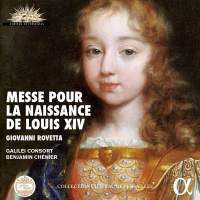Texte paru dans: / Appeared in: |
|
|
Outil de traduction ~ (Très approximatif) |
|
|
Reviewer:
Barry Brenesal France’s Louis XIII and Anne of Austria married in 1615, but it wasn’t until 23 years later that the succession was assured by the birth of a child. News of this arrived in Venice 11 days later—presumably the delay was to assure that the newborn, who would eventually become Louis XIV, survived—and the French ambassador to the Serene Republic organized and funded with state livre a four-day celebration. It was a reasonable choice of a location for major festivities, given Venice’s diplomatic ties to both France and Austria, and its carefully cultivated reputation as a European center of unrivaled splendor.
The timeline is important here. The ambassador commissioned the second most important composer of sacred music in Venice, the assistant maestro di cappella at St. Mark’s, Giovanni Rovetta (c. 1595–1668), to write a Mass honoring the Dauphin. (Monteverdi, his teacher and current maestro, was presumably too busy, and known to be truculent when pressed.) The Messe pour la naissance de Louis was celebrated roughly a month later, in a four-day celebration that also included several bullfights in the Piazza San Marco, a procession of 60 gondolas, fireworks, and many secular musical events. Rovetta had little time to compose on top of his regular duties, as well as to rehearse the large forces necessary for his part in the celebrations. It’s probable as a result that he turned to already composed or partially composed movements, which unlike his usual practice bore nothing in the way of unifying elements, not even key.
This isn’t to say that Rovetta’s three Mass movements—in contemporary Venetian tradition, the Sanctus and Agnus Dei being eliminated—show evidence of haste. They live up to the implied compliment by the Venetian chronicler, Fausto Ciro, that their French patron sought “the most magnificent and solemn music that could be found.” Rovetta was a sophisticated exponent of the so-called Monteverdi School, moving in a similar stylistic direction as his one-time fellow student, Cavalli, in simplifying harmonies, eliminating tension, and focusing more on supple, attractive melody with excellent use of triple time. The Credo is easily the most attractive and varied of the movements, filling its 11-minute span on this release with regular recourse to shifting meters, textures, and size of performing ensemble. Passages that cleverly mingle passing minor chords, brief chromaticisms, and a variety of individual soloists (such as Deum de Deo, Lumen de Lumine) create an intimacy that contrasts brilliantly with the homophonic deployment of Rovetta’s full forces. Occasionally more is evident: His knowledge and application of counterpoint is apparent in the Quoniam tu solas Sanctus section of the Gloria, with its canon on the eighth and bright spray of imitative points. In any case, like a brilliant conversationalist, Rovetta avoids staying too long on any given subject, but constantly finds something new to grab one’s interest.
As usual in music created for an historical event, we know little about what was performed alongside the Messe upon its premiere in Venice’s Basilica of San Giorgio. The customary fashion no doubt prevailed, with vocal and instrumental works both interpolated and surrounding the three movements. Benjamin Chénier has chosen reasonably in adding both a Salve Regina (for the Offertory) and O Maria, quam pulchra (for the Gradual) by Rovetta, since the celebration of the Virgin ties in with Louis XIII’s placing the kingdom of France under her protection when the succession was perceived as in danger. I’m not sure why Rigatti’s works were used to supply a Sanctus and Agnus Dei; true, they satisfy a modern yearning for the “complete” Mass, but are inappropriate in context. Yet Monteverdi’s Adoramus te, performed here in both vocal and instrumental versions, seems fitting to herald the birth of the Dauphin. And Bassano’s Omnes gentes is a fine choice to conclude a celebratory Venetian Mass, with its joyous celebration of a more sublime King—that still might be interpreted as well as praise for Louis XIII.
The performances are uniformly excellent, both for their soloists and for the Galilei Consort’s instrumental forces. All perform with precision and careful phrasing. Rhythms and texts are clearly articulated. Chénier pays close attention to dynamics in a score that relies heavily upon them for part of its chiaroscuro effect. The venue is not over reverberant, and the balance between the vocal and orchestral forces is first-rate. Given the number of recordings of works for varied choral forces with instruments that still have difficulties managing this, the work of Aline Blondiau and Olivier Rosset in this respect deserves recognition. (On a side note, ignore the record jacket’s claim that Rovetta was born in 1698 and died in 1748. The only composer I could find whom those dates would apply to is that underrated Frenchman Henry Madin, but his music isn’t on this disc.)
If you enjoy Monteverdi and Cavalli, chances are you’ll enjoy this fine release spotlighting the seldom heard music of Rovetta. He wrote quite a bit, including madrigals, motets, and instrumental music, which has been poorly surveyed on disc. Hopefully, this album will provoke some ensemble directors and record company producers into examining his music. | |
|
|
|
|
Cliquez l'un ou l'autre
bouton pour découvrir bien d'autres critiques de CD |
|




